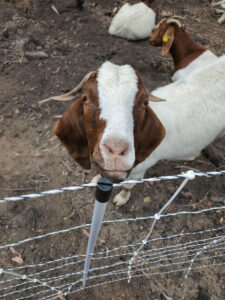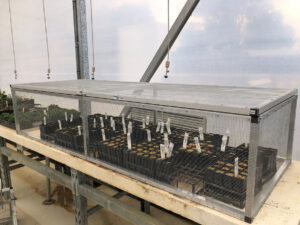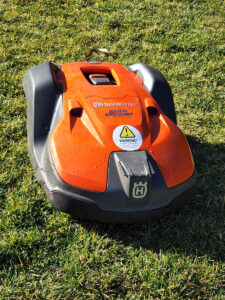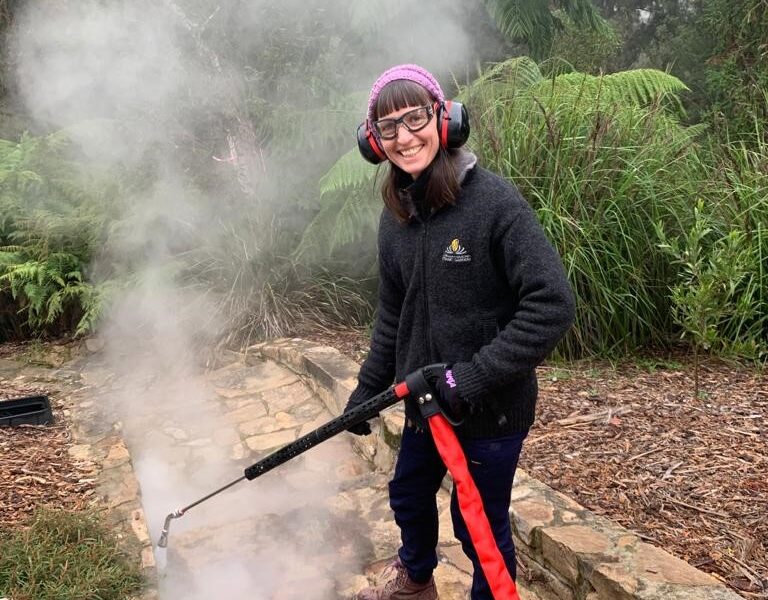Creative approaches to weed and pest management
By Zoe Knapp
Managing plant pests and weeds is an important component of curating any botanic garden. Like many botanic gardens, the Australian National Botanic Gardens applies an Integrated Pest Management approach to minimise herbicide and pesticide use on site.
In recent years, increased rainfall and milder climate conditions, combined with pandemic restrictions and reduced on-site staffing, have increased our need for creative solutions to pest and weed management.

The Gardens is located in central Canberra in the ACT, nestled into the foothills of Black Mountain Nature Reserve, which is dominated by Eucalyptus woodland. The Gardens is Australia’s largest scientifically documented collection of native plants, including many rare and threatened species of which about 300 are listed under the Commonwealth Environment Protection and Biodiversity Conservation Act 1999 (EPBC Act). Over 500,000 people visit annually to enjoy a highly concentrated diversity of native plants. Our high visitation, urban neighbours, diverse living collection and natural bushland surrounds, also bring the challenges of diverse plant pests and weed incursions.
One of the biggest (literally) offenders are the macropods. In numbers, kangaroos and wallabies can rapidly mow down plants, particularly newly planted seedlings. The Gardens’ boundary cyclone fencing helps to control the movement of macropods between the Gardens and surrounding bushland. The fence also helps to control exotic animals such as rabbits and foxes, which are present in low numbers and only occasionally require additional control measures.
On the other hand, exotic animals can sometimes be beneficial. Since the Gardens is located on a sloping and undulating site with many hills and gullies, some areas can be inaccessible for weed removal. In 2020, the Gardens began using a new approach to weed removal, by renting a herd of goats together with an experienced goat-herder. The nimble and hungry goats were able to easily navigate steep slopes and within a few days, had transformed weed infested areas (without important scientific collections) to bare ground and raised the canopy of surrounding trees.

New technology has also changed weed management onsite. The ‘Steamy Wonder’, our new steam weeder, is a vehicle which is fitted with a boiler that super-heats steam, and has a targeted hose to kill weeds without chemicals. The Gardens has also recently employed a robot mower in a newly landscaped area around the café. The battery-operated mower is about the size of a garbage bin lid and lives under the café deck. The mower is programmed to come out at night and mow the 510m2 area of irrigated lawn in the highly utilised space near the café. It is useful for mowing areas inaccessible to regular lawnmowers, and can be programmed to avoid periods of irrigation and visitor use. Restricting the robot to one area also prevents weed transfer to other lawn areas and nearby garden beds.
Our dedicated horticulture team has made an enormous effort to manage weeds while maintaining and developing the gardens and other competing priorities. In addition, the Gardens has established an amazing group of Weedy Volunteers. Working under the guidance of horticulture staff, volunteers have contributed enormously to keeping weeds down and preventing weed escapes when our own native plant species have become too successfully established in their new environments.

In the production nursery, our horticulture team manages some quite different plant pests, in particular common greenhouse pest insects such as scale, aphids and thrips. To help reduce impacts to plants, particularly in enclosed environments, the team applies a strategic range of targeted biocontrol insects. For example, lacewings are predators of many of our common pest insects such as aphids, caterpillars, scale insects and mealybugs. Thripobius javae, a native parasitic wasp, effectively targets greenhouse thrips which can be a difficult pest to control. These beneficial insects are very time-saving compared to manual pest removal. Staff regularly monitor plants using established pest damage thresholds to inform pest treatment.
We have also recently outsmarted clever rodents which were eating seedlings in our propagation houses. This is a risk for maintaining our many threatened species and conservation projects. After several unsuccessful attempts at various makeshift wire cages, our Trades team developed an innovative reinforced rodent-proof cage design. The cages are lightweight, with open wire to allow for overhead plant watering and have a hinged lid. Keeping the rodents at bay might also prevent regular visits by large brown snakes.
These various creative solutions to plant pests and weeds have been invaluable at maintaining high curation standards at the Gardens.
Zoe Knapp
Conservation Manager
Australian National Botanic Gardens (ANBG)
E: Zoe.Knapp@environement.gov.au
https://www.anbg.gov.au/gardens/
Main photo: The Steamy Wonder for weed management (Image: ANBG)

